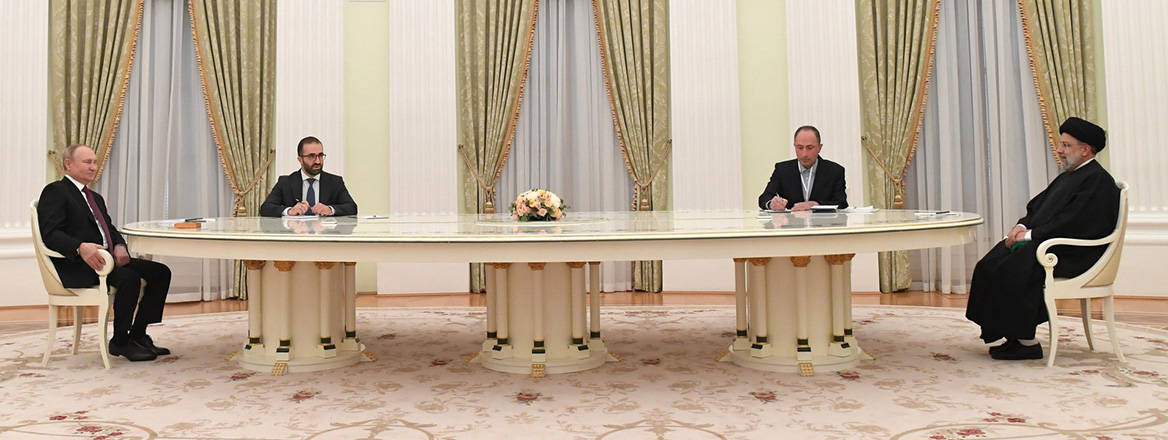While the Iranian president was left disappointed by the extent of Russian commitments after his recent trip to Moscow, work on an overarching deal between the two countries is set to continue.
In what has commonly been described as his first major foreign trip since becoming Iranian president, Ebrahim Raisi paid an official two-day visit to Moscow last month. Coming at the back of a turbulent time when the prospects of reviving the ill-fated JCPOA hang in the balance and Iran’s economic woes are worsening, Raisi boarded the Presidential Airbus with high hopes. Describing his trip as critical in his pre-departure remarks at Mehrabad Airport, the cleric’s most important objective was to secure Russia’s consent to the signing of a new long-term strategic pact which would pave the way for the establishment of bilateral mechanisms aimed at circumventing Western sanctions.
A staunch critic of his predecessor’s alleged pro-Western leanings, Raisi’s trip was also meant to allow him to claim a major foreign policy victory by consolidating Iran’s turn towards the East. Much to his dismay, all Raisi got was a promise from his Russian counterpart to instruct his foreign ministry to start working on the Iranian proposed draft of the agreement, while ignoring Iran’s demand for the signing of an advanced weapon purchase deal. Still, the sudden – and indeed radical – change of official narrative on the nature of Iran–Russia relations since the official announcement of Raisi’s trip indicates that a deal of some sort will be finalised. Using their control over the media, Raisi’s allies have been busy setting in motion a coordinated campaign to promote a new narrative on the historical context of Moscow–Tehran relations – one that seeks to downplay Moscow’s assaults on Iranian sovereignty in the past while completely ignoring Russia’s uncooperative stance during the previous round of nuclear talks, as well as its failure to deliver the S300 missile defence system on time.
Notwithstanding the fact that the details of the deal have not been fully worked out yet, one can safely speculate that it will go beyond remedying the two sides’ mutual desire to reduce their economic vulnerabilities to Western and/or US-led financial sanctions. Instead, and perhaps more importantly, it will be built on their common concern regarding the geopolitical and geo-economic implications of the all-Turkic Zangazur Corridor and the increased prospect of a NATO encroachment into Central Asia. The deal might also pave the way for a joint Russo-Persian approach towards deradicalisation in the Middle East, the Caucasus and Central Asia.
As Turkey seeks to expand its presence in Central Asia, Russian and Iranian officials have been worried about the fast-growing presence of a NATO member state along their borders
Ever since Azerbaijan’s victory over Armenia in the 2020 Nagorno-Karabakh War, Iranian and Russian officials have been uneasy about Ankara’s fast-expanding presence in both the Caucasus and Central Asia. Such concerns reached a climax when Azerbaijan announced the construction of the Zangazur Corridor in close cooperation with Turkey. Upon its completion, the corridor will bypass Iranian and Russian territories and instead directly connect Central Asian markets and resources to Turkey and, by extension, Europe. By doing so, it will drastically reduce the geopolitical significance of the Iranian–Russian backed International North–South Transport Corridor (INSTC) – a grander version of the so-called Persian Corridor which would ultimately connect Mumbai to St Petersburg.
Viewed from Tehran and Moscow, this is considered problematic because it provides a direct route for Turkmen and Kazakh resources to European markets – a prospect that both countries, and Russia in particular, have been adamant to prevent in order to protect their own share of the European energy market. For the Iranians, the immediate headache lies in Zangazur’s potential to put an end to Ankara’s dependency on Iran, thereby depriving the regime of a source of strategic influence and foreign currency. Lacking direct land routes into Central Asia, Turkey has had no option but to rely on Iran for the import and export of goods to and from Central Asia. With an eye on extracting political or strategic concessions from its neighbour, Tehran has frequently increased transit fees at very short notice.
Equally worrisome is the potential of the corridor for facilitating troop movements in and out of Central Asia for NATO forces – a prospect that could raise eyebrows in Beijing as well. As Turkey seeks to expand its presence in Central Asia, Russian and Iranian officials have been worried about the fast-growing presence of a NATO member state along their borders. They also fear that the Turkish presence could eventually galvanise pan-Turkic sentiments among the region’s sizeable Turkic population, thereby undermining regional stability. It is indeed interesting to note the overwhelmingly negative tone of analysis and commentaries in the Turkish media in the aftermath of the deadly protests in Kazakhstan in early 2022. Some pro-government papers have gone as far as accusing Moscow of fomenting the unrest as an excuse for stationing its troops in the country, so that it can better monitor – and if needed curb – Turkish advances in Central Asia.
With Iran weak and in desperate need of allies, Moscow is now in a position to use an eventual pact to clip Tehran’s strategic wings even further
Finally, there has been talk of a common Iranian–Russian media campaign to fight religious extremism in the Middle East and Central Asia. Satisfied with the outcome of their cooperation in defeating Sunni extremist groups in Syria, and uneasy about the likelihood of a rising tide of jihadism in Central Asia in the aftermath of the Taliban’s return to power in Afghanistan, Iran and Russia may choose to pursue a joint approach towards deradicalisation, which would complement the Shanghai Cooperation Organisation’s anti-terrorism agenda. What format such an approach would take and what content it would disseminate, however, are open questions.
As work on the deal progresses, it serves as yet another indication of Iran’s departure from its ideal of ‘neither East nor West’ – an unwelcome development for a country that, by the virtue of its geography, is best served if it pursues a non-ideological, non-aligned foreign policy so it can fulfil its potential as a conduit of trade and commerce between South Asia and Europe. Alas, its Supreme Leader’s ideological obsessions will not allow for such a strategic realignment.
Looking ahead, therefore, it is fair to assume that the eventual deal will provide a strong impetus for the construction of the various road and rail links that collectively form the giant 7,200 km-long INSTC. Fearing that the corridor would substantially increase Iran’s influence as both an energy producer and a critical commercial and trade node through which the bulk of the INSTC’s associated routes pass, Moscow has been reluctant to devote its limited resources to seeing through its commitment towards the completion of the corridor. And US sanctions on Iran have been a useful excuse for Moscow to justify its patchy commitment to the project. With Iran weak and in desperate need of allies, Moscow’s concerns have substantially subsided, and it is now in a position to use the pact to clip Tehran’s strategic wings even further and ensure its full cooperation in the management of the corridor and Russia’s broader regional agenda. By doing so, Moscow would also take a critical step in further cementing its already strong relations with India, whose geostrategic outreach to Central Asia has been severely hindered by its lack of direct land routes to the region, giving it a vested national security interest in the completion and operationalisation of the INSTC.
The views expressed in this Commentary are the author’s, and do not represent those of RUSI or any other institution.
Have an idea for a Commentary you’d like to write for us? Send a short pitch to commentaries@rusi.org and we’ll get back to you if it fits into our research interests. Full guidelines for contributors can be found here.


